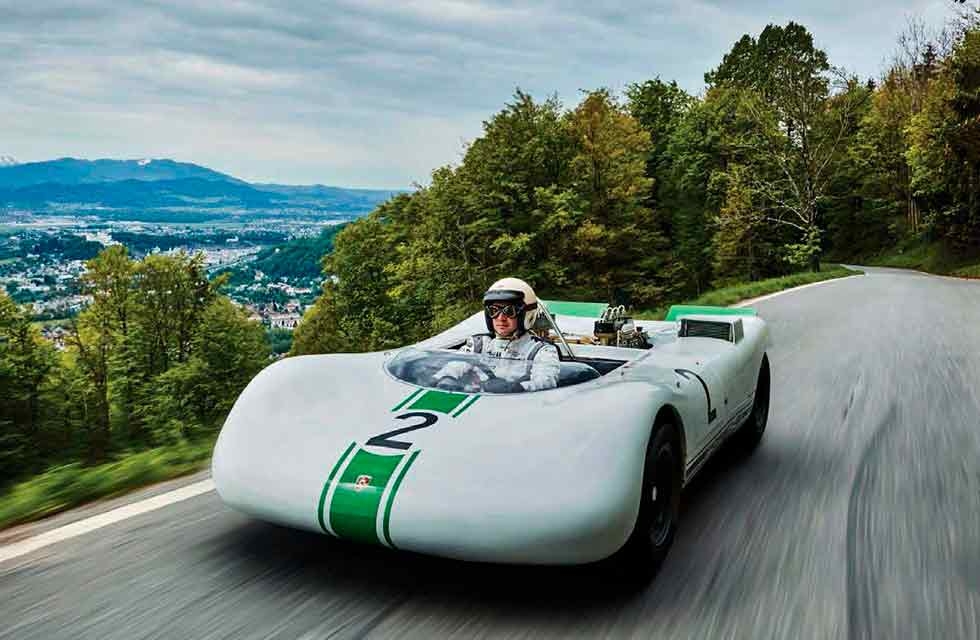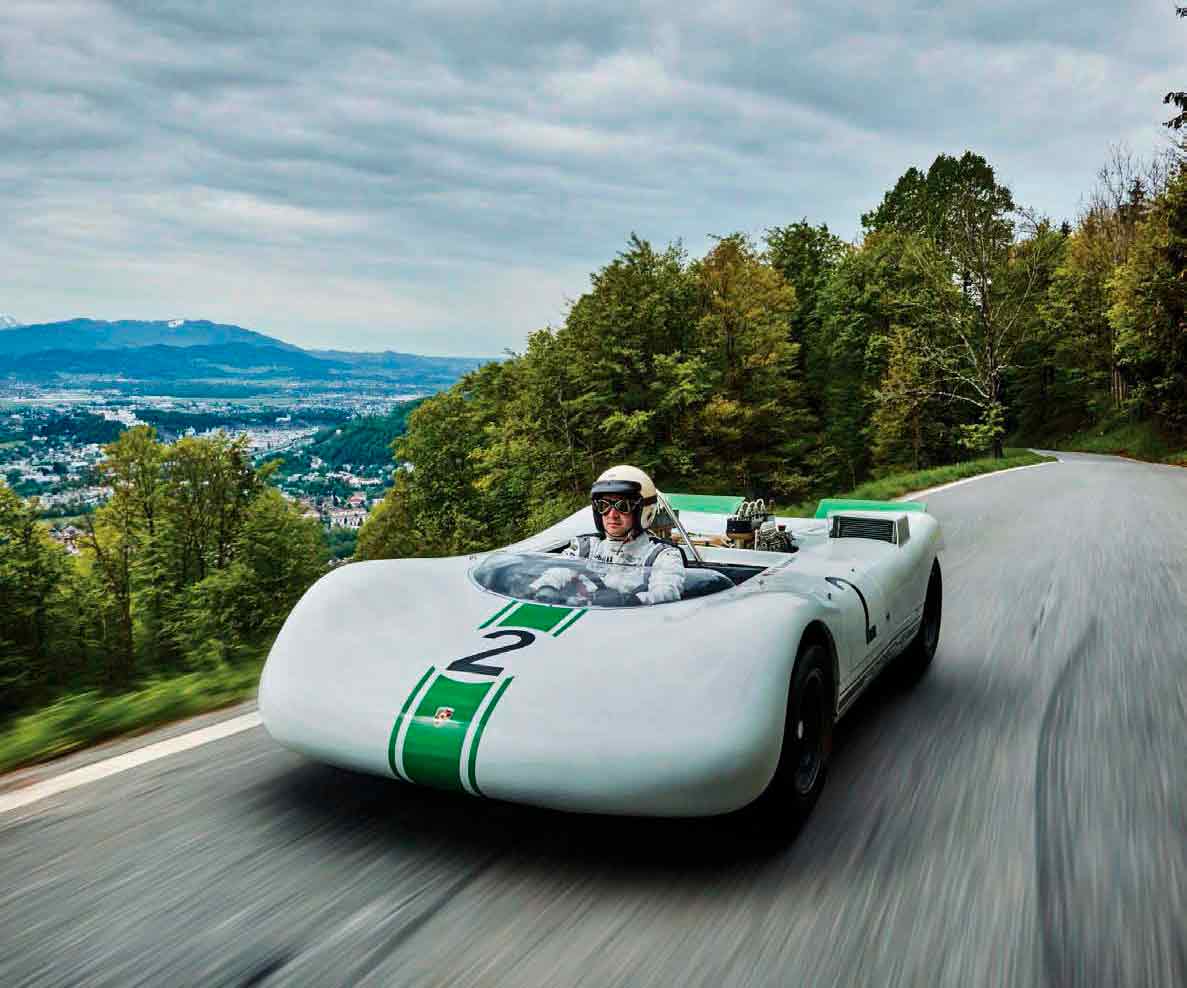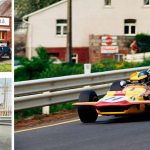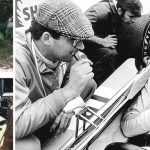
No Porsche has ever been so simple in concept, yet featured such radical technical solutions as those implemented on the 909 Bergspyder. But despite its technological brilliance, the 909 never won a race, although it remains something very special in the memories of its designers. Porsche’s wild child returned to the mountain where it contested its first ever event… Words: Berthold Dörrich/Keith Seume. Photos: Katja Dalek.
BERGSPYDER
The Type 909 Bergspyder returns to the scene of its first ever hillclimb
The history of ‘mountain racing’ is peppered with famous names: Mont Ventoux, Pikes Peak, La Turbie, Rossfeld, Ollon-Villars, Klausenpass, Großglockner… And although ranked lower in the echelons of legendary venues, the Gaisberg near Salzburg is another of them. It was never witness to major dramas. Certainly, as was often the case with almost all major hillclimbs, lesser-known racers died against its rocky outcrops, or after veering off the road into its deep gorges. But its slopes never claimed the lives of any of the great names in racing.


The Gaisberg itself is rather unspectacular compared to the Alpine giants, which can be found a few kilometres further south and climb to over 3000 metres – it barely rises to 1300 metres and is forested all the way to the top. In fact, it was better described using the English term ‘hillclimb’, rather than the more exciting term ‘mountain racing’ favoured by those more familiar with the famous Alpine passes.
“MITTER JUDGES THE CAR TO BE UNPREDICTABLE AT THE LIMIT…”
And yet here on 8th September 1968, what was probably the most uncompromising Porsche racing car ever built made its first public appearance. It would also prove to be its penultimate appearance – in fact, this marked the penultimate appearance of any works Porsche at a mountain race as the era of the Porsche team competing at the big mountain races drew to an end. Porsche had confidently won the championship the previous year and was on track to win it again in 1968, although by then the decision had already been made to concentrate on winning the long-distance sports car world championship title from 1969 onwards.
But back in 1968, and since the regulations governing the European Hillclimb Championships had the previous year dispensed with the requirement for vehicles in the two-litre class to meet a minimum weight, race engineers across all teams began to pay special attention to how the already delicate mountain race cars could be made even lighter.
“HE CHECKED TO MAKE SURE NOTHING WAS MADE OF STEEL…”
For Porsche’s racing department, reducing all-up weight had been a prime objective since the start of the 1965 season, with British constructor Colin Chapman’s mantra of ‘adding lightness’ being their inspiration. It is said that Chapman’s obsession with low weight led him to state ‘the best car is the one which breaks just after the finishing line’ – certainly his Lotuses had a reputation for fragility unrivalled by the likes of Porsche or Abarth.
Porsche’s main rival at this time was, unsurprisingly, the Italian Ferrari team, the Scuderia’s red sports cars being the ones to watch on the mountains for several years. Driven by Ludovico Scarfiotti, the V6-engined Dino 206P with its Formula 1 ‘genes’ had been the car to beat since the beginning of the 1965 season while, to add insult to injury, Porsche veteran Hans Herrmann drove an Abarth with some success.
Porsche’s 904– and Porsche 910-based eight-cylinder cars were to prove too heavy to remain competitive against such opposition. In 1964, Porsche went so far as to buy in lightweight chassis from British-based Elva, to create the Elva-Porsche, a situation which, it is said, didn’t please the incoming Ferdinand Piëch. After all, it was tantamount to an admission that while Porsche’s race shop could build engines, it couldn’t build a good chassis. Piëch took up his role as head of development for Porsche racing in 1965. With his meticulous attention to detail, he encouraged his employees to build the lightest possible car to tackle the hillclimb championship. ‘We went further in mountain racing than aerospace,’ said Piech in an interview. At a time when the Americans were preparing to land on the moon, Piech boasted that the springs used on his mountain racers were made of titanium, whereas the wheels of the moon vehicles were still only made of steel…
By 1967, Porsche had become more competitive with the 910 Bergspyder, which weighed in at a modest 500 kilos, and by the end of the season the Spyder is said to have weighed just 419 kilos, having been placed on a diet by its creators. But there was more to come. Local spectators attending the Gaisberg hillclimb in September 1968 paid relatively little attention when Porsche rolled out two completely new racing cars alongside the tried and tested 910. Hermann Schwarz, editor of the book ‘90 Years of the Gaisberg Race’ recalls: ‘At the time, the paddock was in the Porsche yard right next to the Salzburg train station. We went there as boys to look at them but to us the 909 was just another Porsche racing car.’
You couldn’t tell from looking that the 909 weighed just 385 kilos – a ‘fighting weight’ that no Porsche has ever undercut. The fact that nobody paid the 909 much attention is no surprise as Porsche hadn’t made any fuss about the new car ahead of its race début. The low-key nature of the 909’s presentation served to disguise the many technological tricks that Piëch and senior race engineer Peter Falk had incorporated in the design in an effort to redress the balance of power between Porsche and its rivals. Strictly speaking, by this time Ferrari was no longer the dominant force in the series and it is arguable that the 909 was a way for Piëch to test some of his more radical ideas ahead of the new season.
In retrospect, Peter Falk confirms that this was indeed the case: ‘On the one hand, the engineers always wanted to try out their ideas, and to make the most of the technical possibilities. On the other hand, the Porsche 917 was already in development in the summer of 1968, by which point it was already clear that it would not be suitable for events such as the Targa Florio or those held at the Nürburgring, hence the need for a small, manoeuvrable sports car.’
The European Hillclimb Championship with its comparatively relaxed regulations offered the opportunity to test more radical ideas under race conditions. Perhaps the fact that the successful 910 Bergspyder originally started life as a circuit racer meant it had never been developed in the way that Piëch had in mind. Something more had to give! At the end of the 1968 season, the 909 emerged as the most radical racing car ever built by Porsche. The fact that it never proved particularly successful is, in retrospect, mainly due to the fact that, with its numerous innovations, the 909 never benefited from sufficient test and development time.
It was, though, an intriguing design in so many ways, compared to the 910. In order to put more weight on the front wheels, the engine/gearbox unit had to be moved forward significantly. The designers succeeded in doing this by placing the differential behind the gearbox. The driver then sat in the car as far forward as possible, a design which became customary later in many racing cars but with little regards to driver safety.
In the event of a collision, the legs and feet protruded beyond the front axle and were surrounded by a paper-thin GRP body – a layout which is quite unthinkable today. Incredibly and ‘completely without cynicism’, as he notes in his autobiography, Piëch saw the advantages of this layout in his mind thus: ‘If you have your feet so far forward, you will make every effort to avoid an impact.’
Instead of using traditional coil springs, Peter Falk designed the front suspension with an extremely light titanium Z-shaped torsion bar, which allowed fine adjustments to be made. It was all part of the plan by which Piëch encouraged his team to work at unbelievable speed in the pursuit of saving weight. Klaus Bischof, later head of historic motorsport at Porsche, who was a young mechanic at the time, remembers: ‘After the (909) was completely assembled, Piëch asked us to completely disassemble it and spread everything out neatly on white sheets. He then checked with a magnet to make sure that no part, no screw, nothing was made of steel. Since we knew how pedantic he was, we made sure we paid attention to everything. Or so we thought. The casing of the oil pressure gauge turned out to be made of steel and had to be replaced immediately with a plastic one – then we threw the instrument away altogether because the drivers didn’t look at it in the race anyway!’
Porsche had increased its factory line-up to three drivers for the 1968 season: Gerhard Mitter and Rolf Stommelen had already become rivals in the Porsche team on the mountain courses for some time and fought closely. How close the two were to each other had been proved the previous season, when they ended up with the same number of points. Mitter had only become European champion due to better placings.
For Piëch this was obviously not competition enough – he seemed to want total dominance. There is no other way to explain it, as Porsche also hired the previous season’s Ferrari star driver Ludovico Scarfiotti for the ’1968 season and thus competed with three factory cars. One can only imagine what reaction this coup must have triggered at Modena…
However, when the Porsche team arrived in Gaisberg in September 1968 in the warm late summer weather, the line-up had been tragically reduced to two drivers. Scarfiotti unexplainably went off the road in testing for the second race of the season at Rossfeld and died when his Porsche 910 broke up after hitting trees 50 metres below the course. After intensive investigations it was decided that the accident couldn’t be attributed to a material defect as a result of the Porsche’s extremely lightweight construction. Had that been the case, who knows if the 909 would ever have been raced?
For the first practice runs, the two brand new 909 Bergspyders were lined up at the start in Guggenthal, Mitter’s 909-001 bearing the number 95T and Stommelen’s 909-002 the number 96T. The ‘T’ signified that the cars were used for ‘training’ – in case the 909s didn’t perform as expected, Porsche had brought two 910 Spyders (wearing the start numbers 95 and 96), which had proved to be reliable and dominant so far during the season. This was also an obvious opportunity to determine their real potential in a direct duel with the 909.
‘Mr Mitter judges the car to be unpredictable at the limit,’ the racing department later noted in its test and calculation report. ‘He definitely wanted to drive the 910,’ was the conclusion after two training runs. The 909’s front brakes locked up and it was very nervous on the bumps on the way up the Gaisberg course. In addition, the engine was anything but perfect. Stommelen’s car also gave cause for concern during the practice runs, lost traction several times at the start or when shifting from 1st to 2nd gear, and then suffered gearbox problems. Stommelen, nevertheless, decided to use the 909. ‘It feels safer in the 909 compared to the 910’, noted the Porsche driver. Peter Falk suspects another motive: ‘Mitter was always fixated on the result. Stommelen always had one eye on the public image…’
In the end there was no happy ending. For the race on Sunday, the mechanics fitted Stommelen’s 909-002 with the engine from Mitter’s car, which had proved to be more reliable. They suspected that the engine problems had probably been caused by another revolutionary idea from Piech’s bag of weight loss tricks.
There was no normal fuel tank and pump fitted to the 909. Instead, the fuel was contained in a spherical tank made of titanium into which the bladder from a football was inserted. The tank was filled with the minimal 14-litres required to complete the hillclimb course and the football bladder then inflated, pressurising the tank to between 6 and 10 atu. This dispensed with the need for a conventional fuel pump. It was an ingenious system, but one which was obviously not yet fully developed – or as Peter Falk describes it: ‘The highlight that unfortunately did not become the highlight. An extremely expensive piece that Mr Piëch insisted upon because it was his idea.’ The design failed several times because either a valve on the titanium tank leaked or the rubber bladder was covered in glue preventing the tank from being filled completely.
Even if the suspected problems could not be proven in tests after the race, the system was obviously so dubious in the eyes of the engineers at Porsche that it was never used again after that first run at Gaisberg. In the last event held on Mont Ventoux, Mitter started one last time in 910-034, while the engineers fitted a conventional petrol pump to Stommelen’s 909, much to the annoyance of Piëch. Peter Falk remembers: ‘Piëch was convinced that his idea had to work, but it was clear to us that we couldn’t sort it out in the two weeks between races. We never got permission to install a fuel pump, so that’s why we didn’t ask for it – we simply went ahead and fitted one.’
The revolutionary 909 failed to win at Gaisberg, or at the last race of the season at Mont Ventoux. Instead, Gerhard Mitter won both races in the 910 and became European Hillclimb Champion ahead of teammate Rolf Stommelen. Ferrari won the European Championship title the following year without serious competition, but by now the days of great duels on the mountain were over.
Porsche turned all its attention to endurance racing – the 917 which debuted the following year was from now the main centre of focus as far as Porsche’s racing department was concerned. Only in the extremely successful 908/3 did the spirit of the 909 Bergspyder live on…
Above: It was a brave man who drove the short-wheelbase 909 to its limits. Austrian Le Mans winner Richard Lietz had the privilege of piloting the 909 on its first drive on the Gaisberg mountain course since 1968. Below: Now imagine where the driver’s feet are in relation to the front wheels. The consequences of a frontal accident don’t bear thinking about. Piëch said ‘If you have your feet so far forward, you will make every effort to avoid an impact…’ Above: An engine, four wheels, a gearbox and a steering wheel – what else does a driver need? 909 was minimalist in the extreme. Below left: 909-002 was driven by Rolf Stommelen at Gaisberg. 909-001 was the car driven by Gerhard Mitter Below right: Adjustable tail flaps were linked to the rear suspension uprights.
Above: Lightweight aluminium frame could be picked up by one person, while the glassfibre body panels were paper-thin Below left: Vestigial rollbar offered minimal protection in the event of an accident – but weighed little… Below right: Spherical fuel tank was pressurised using a football bladder, but the system proved troublesome. Without Piëch’s permission, the mechanics installed an electric pump (just visible to the left of the tank) to solve fuel delivery problems. Above: Wind-cheating profile combined with ultra-low weight helped give the 909 Bergspyder a competitive edge, although sadly it was never a race winner. Opposite: Engine is a Type 771 2.0-litre flat-eight producing 275bhp at 9000rpm. Note the differential unit is placed at the rear of the gearbox, to move engine further forward. Below left to right: Gaisberg hillclimb celebrated its 90th birthday last year; Ferdinand Piëch was the driving force behind the 909 project: Rolf Stommelen finished runnerup to team mate Gerhard Mitter in 1967 and ’1968. Above: Porsche took the Bergspyder back to Gaisberg in a re-enactment of its first competitive outing back in September 1968. Photo gives you some idea of how vulnerable the driver was…











